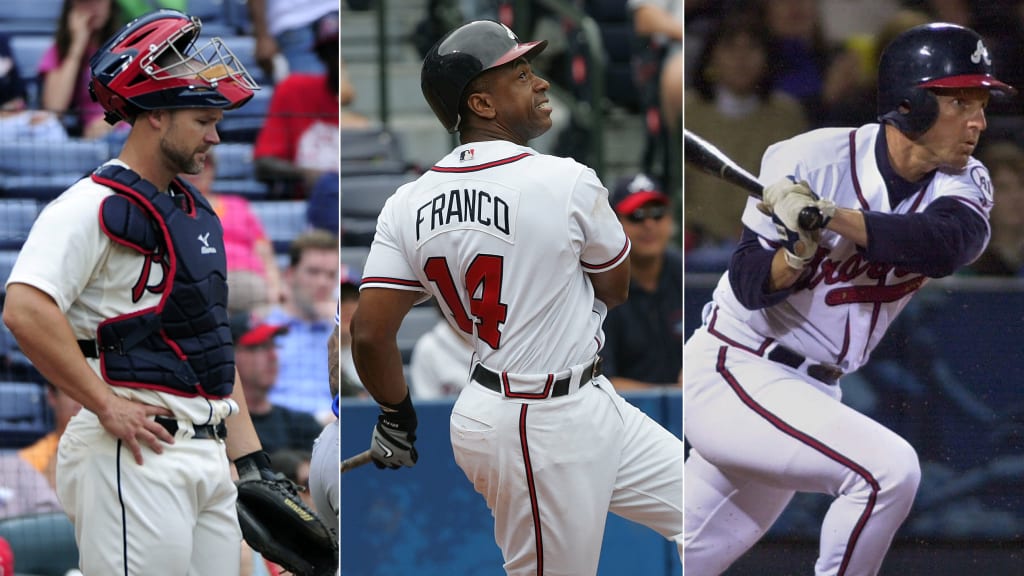
No one loves a good debate quite like baseball fans, and with that in mind, we asked each of our beat reporters to rank the top five players by position in the history of their franchise, based on their career while playing for that club. For bench players, we deviate from the Top 5 format to discuss what exactly makes a player a bench player and dissect the many ways they provide value.
Here is Mark Bowman’s assessment of the top bench players in Braves history.
You can argue the most valuable bench player in Braves history is a guy who did not play his first game for the club until he was 42. Yet, he still has tallied more pinch-hit plate appearances than all but two players in franchise history.
But before giving the honor to Julio Franco, it would seemingly be in my best interests to evaluate Keith Lockhart’s candidacy. Along with having the most pinch hits in franchise history, the infielder also was my mother’s favorite Brave of the late 1990s and early 2000s.
Speaking of favorites, Martin Prado ranks near the top of any list of all-time favorite Braves. Prado spent a few years on Atlanta’s bench, but he was compiling 450-plus plate appearances over each of his final four years in town. So we’ll keep him for the list of top utility players and focus more on true backups like former catchers David Ross and Eddie Pérez.
Perez’s value is rooted in the 2.73 ERA Greg Maddux produced while using Perez as his personal catcher from 1996-2000. But it extends to what Perez did in 1999, when he assumed the injured Javy Lopez’s starting role over the regular season’s final three months and then was named the 1999 National League Championship Series Most Valuable Player Award winner.
Many likely remember the home run Ross hit to give the Braves an early lead during the 2012 NL Wild Card Game against the Cardinals. Did you also know that he produced a 1.0 bWAR or higher during each of the four seasons he spent in Atlanta as Brian McCann’s backup?
Why is that significant? Well, Ross never logged 200 plate appearances during any of his seasons with the Braves. Ty Cline (1963-64) and Hank Gowdy (1917-21) are the only other players in franchise history to produce a 1.0 bWAR or better in multiple seasons consisting of fewer than 200 plate appearances. Neither of them did so more than twice.
Ross is certainly the best backup catcher in Braves history. Given the significance of that role, we could just crown him the best bench player in franchise history right now. But that would be disrespectful to Lockhart, who certainly exceeded the expectations some fans might have had when the Braves acquired him in the trade that sent Jermaine Dye to Kansas City just before the start of the 1997 season.
While spending six seasons in Atlanta, Lockhart collected more pinch hits (59) and pinch-hit plate appearances (284) than anybody else in franchise history. But within this span, he also made at least 100 more starts than Mark Lemke, Bret Boone, Tony Graffanino or any other second basemen Atlanta employed.
So you have to question whether you should consider Lockhart or Franco to be bench players. After being plucked out of the Mexican League with one month left in the 2001 season, a 42-year-old Franco arrived in Atlanta and immediately became the starting first baseman for a division winner, which had unsuccessfully employed Rico Brogna and Ken Caminiti at the position earlier that year.
Franco hit .272 over 194 career pinch-hit plate appearances for the Braves. He didn’t have the power of Tommy Gregg, who produced a .800 OPS as a pinch-hitter for Atlanta from 1988-97. But the ageless wonder did produce while platooning at first base and serving as one of Bobby Cox’s most reliable pinch-hitters.
Still, you have to account for the fact Franco logged over 300-plus plate appearances during two of his four full seasons in Atlanta. So, if focusing strictly on which player brought the most value to Atlanta’s bench, you have to go with Ross, whose value to the pitching staff and clubhouse extended beyond those 1-plus-WAR figures he produced with fewer than 200 plate appearances.



